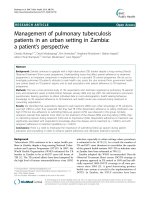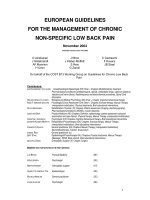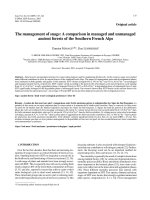Management of ivig non responders in kawasaki disease
Bạn đang xem bản rút gọn của tài liệu. Xem và tải ngay bản đầy đủ của tài liệu tại đây (1.06 MB, 18 trang )
EVIDENCE BASED MEDICINE
MANAGEMENT OF IVIG NON-RESPONDERS
IN KAWASAKI DISEASE
MD. TRẦN THỊ HOÀNG MINH
1
CONTENT
1
BACKGROUND
2
IVIG RETREATMENT
3
STEROIDS
4
OTHER IMMUNOSUPPRESSION
5
OTHER TREATMENT
2
Background
IVIG non – responders: persistent or recrudescent fever
≥36-48 hours after the completion of the initial IVIG
infusion
The incidence : 10 – 20%
IVIG non-responders: increased risk of CAAs
Optimal therapy: controversial
3
Additional IVIG treatment
High-dose intravenous
pulse methylprednisolone
(IVMP)
TNF-α blockade
Cyclosporine A
IL-1 blockade
Methotrexate
Anti-CD20
4
IVIG retreatment
Recommend IVIG 2g/kg (Level C)
Newburger JW, Takahashi M, Gerber MA et al. Diagnosis, treatment, and long-term management of Kawasaki disease: a
statement for health professionals from the Committee on Rheumatic Fever, Endocarditis, and Kawasaki Disease, Council on
Cardiovascular Disease in the Young, American Heart Association. Pediatrics 2004;114:1708-33.
5
Steroids
6
Steroids
7
Steroids
as second-line treatment (i.e., in patients after initial
IVIG failure)
or as third-line treatment (i.e., in patients after nonresponse to repeated IVIG infusions)
faster resolution of fever
similar rate of CAAs compared to IVIG retreatment
8
TNF-α blockade
9
TNF-α blockade
TNF-α: key pro-inflammatory cytokine
Elevated plasma level of TNF-α: increased risk of CAA
TNF blockade: infliximab and etanercept
Infliximab (5 mg/kg): Rapid improvement of
inflammatory symptoms and markers, no adverse side
effects
10
Cyclosporine A
Suzuki et al (2011) :
Pilot study (329 KD pts)
28 Japanese patients with IVIG non-response
cyclosporin A dose: 4-8 mg/kg/day
18 pts: afebrile within 3 days (64.3%), 4pts within 4-5
days
Tremoulet et al (2012) : case series of 10 KD pts
rapid defervescence and resolution of inflammation
Suzuki H, Terai M, Hamada H et al. Cyclosporin A treatment for Kawasaki disease refractory to initial and additional intravenous
immunoglobulin. Pediatr Infect Dis J 2011;30:871-6.
Tremoulet AH, Pancoast P, Franco A et al. Calcineurin Inhibitor Treatment of Intravenous Immunoglobulin- Resistant Kawasaki
Disease. J Pediatr 2012
11
IL-1 blockade
Case reports
In a mouse model for KD: Lee et al showed that IL-1β is
indeed critically involved in the coronary arteritis and that
the coronary lesions can be prevented by IL-1RA
treatment
Lee YH, Schulte DJ, Shimada K et al. IL-1beta is Crucial for Induction of Coronary Artery Inflammation in a Mouse Model of
Kawasaki Disease. Circulation 2012 February 2
12
Methotrexate
Case series
In a subsequent trial by Lee et al:
low-dose oral methotrexate therapy (10 mg/m², once
weekly until CRP levels normalized)
17 IVIG non-responsive patients
Methotrexate: prompt resolution of fever and rapid
improvement of inflammatory parameters
Lee TJ, Kim KH, Chun JK, Kim DS. Low-dose methotrexate therapy for intravenous immunoglobulinresistant Kawasaki
disease. Yonsei Med J 2008;49:714-8
13
Anti CD20 treatment
Sauvaget et al: a single case of a child with KD who was
successfully treated with rituximab (15 mg/kg/day)
Sauvaget E, Bonello B, David M, Chabrol B, Dubus JC, Bosdure E. Resistant Kawasaki Disease Treated with AntiCD20. J Pediatr 2012
14
Other treatment
Plasma exchange
Ulinastatin:
inhibits neutrophil elastase and prostaglandin H2
synthase
Kanai et al:
ulinastatin plus IVIG and aspirin (n=369) compared with
patients treated with conventional therapy (n=1178).
ulinastatin was associated with fewer patients requiring
additional rescue therapy (13% vs. 22%; P<0.001) and a reduction
in CAA formation (3% vs. 7%; P=0.01)
used in Japan as an adjunctive therapy for KD patients
Kanai T, Ishiwata T, Kobayashi T et al. Ulinastatin, a urinary trypsin inhibitor, for the initial treatment of patients with
Kawasaki disease: a retrospective study. Circulation 2011;124:2822-8.
15
Conclusion
IVIG retreatment: recommend
Other drugs: IVMP, infliximab and anti-IL-1 treatment
Need more researchs
16
REFERENCES
Newburger JW, Takahashi M, Gerber MA et al. Diagnosis, treatment, and long-term
management of Kawasaki disease: a statement for health professionals from the Committee on
Rheumatic Fever, Endocarditis, and Kawasaki Disease, Council on Cardiovascular Disease in the
Young, American Heart Association. Pediatrics 2004;114:1708-33.
Hashino K, Ishii M, Iemura M, Akagi T, Kato H. Re-treatment for immune globulin-resistant
Kawasaki disease: a comparative study of additional immune globulin and steroid pulse therapy.
Pediatr Int 2001;43:211-7.
Ogata S, Bando Y, Kimura S et al. The strategy of immune globulin resistant Kawasaki disease: a
comparative study of additional immune globulin and steroid pulse therapy. J Cardiol
2009;53:15-9.
Burns JC, Best BM, Mejias A et al. Infliximab treatment of intravenous immunoglobulinresistant Kawasaki disease. J Pediatr 2008;153:833-8
Mori M, Imagawa T, Hara R et al. Efficacy and Limitation of Infliximab Treatment for Children
with Kawasaki Disease Intractable to Intravenous Immunoglobulin Therapy: Report of an Openlabel Case Series. J Rheumatol 2012
C.E. Tacke, D. Burgner et al. The management of acute and refractory kawasaki disease. Expert
Review of Anti-Infective Therapy 2012 Oct;10:1203-15
17
Thanks for your attention
18









